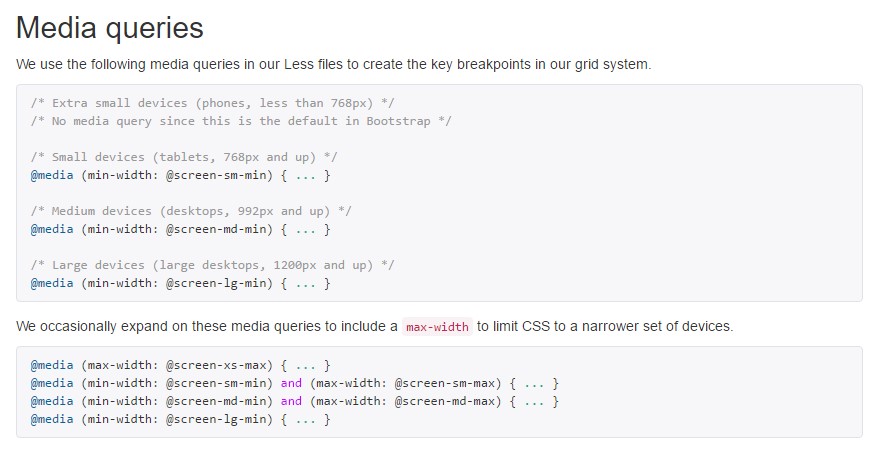Bootstrap Media queries Grid
Intro
Just as we said earlier within the modern net that gets viewed practically equally simply by mobile and desktop computer devices getting your webpages adjusting responsively to the display screen they get presented on is a condition. That is actually the reason why we own the powerful Bootstrap framework at our side in its current fourth version-- currently in development up to alpha 6 introduced at this point.
However precisely what is this aspect beneath the hood that it really applies to execute the job-- exactly how the web page's material becomes reordered as needed and precisely what helps to make the columns caring the grid tier infixes just like
-sm--md-The ways to employ the Bootstrap Media queries Grid:
The responsive activity of the most famous responsive framework inside of its latest 4th edition comes to work due to the so called Bootstrap Media queries Css. Things that they work on is having count of the size of the viewport-- the display screen of the device or the size of the internet browser window in the case that the page gets showcased on desktop and utilizing various styling regulations as required. So in common words they use the simple logic-- is the width above or below a certain value-- and pleasantly trigger on or off.
Every viewport dimension-- just like Small, Medium and more has its very own media query identified besides the Extra Small display screen scale which in newest alpha 6 release has been applied widely and the
-xs-.col-xs-6.col-6The general syntax
The general format of the Bootstrap Media queries Override Css inside the Bootstrap framework is
@media (min-width: ~ breakpoint in pixels here ~) ~ some CSS rules to be applied ~@media (max-width: ~ breakpoint in pixels here ~) ~ some CSS ~Another factor to consider
Exciting factor to notice here is that the breakpoint values for the several display scales differ by a single pixel depending to the rule which has been actually used like:
Small display screen sizes -
( min-width: 576px)( max-width: 575px),Medium display dimensions -
( min-width: 768px)( max-width: 767px),Large screen size -
( min-width: 992px)( max-width: 591px),And Extra big screen sizes -
( min-width: 1200px)( max-width: 1199px),Responsive media queries breakpoints
Considering Bootstrap is really produced to be mobile first, we work with a fistful of media queries to develop sensible breakpoints for formats and user interfaces . These kinds of breakpoints are primarily based on minimum viewport sizes as well as make it possible for us to graduate up elements while the viewport changes. ( visit this link)
Bootstrap mainly makes use of the following media query ranges-- or breakpoints-- in source Sass data for style, grid structure, and components.
// Extra small devices (portrait phones, less than 576px)
// No media query since this is the default in Bootstrap
// Small devices (landscape phones, 576px and up)
@media (min-width: 576px) ...
// Medium devices (tablets, 768px and up)
@media (min-width: 768px) ...
// Large devices (desktops, 992px and up)
@media (min-width: 992px) ...
// Extra large devices (large desktops, 1200px and up)
@media (min-width: 1200px) ...As we formulate resource CSS in Sass, all of media queries are definitely obtainable through Sass mixins:
@include media-breakpoint-up(xs) ...
@include media-breakpoint-up(sm) ...
@include media-breakpoint-up(md) ...
@include media-breakpoint-up(lg) ...
@include media-breakpoint-up(xl) ...
// Example usage:
@include media-breakpoint-up(sm)
.some-class
display: block;We occasionally use media queries that move in the some other way (the given screen size or more compact):
// Extra small devices (portrait phones, less than 576px)
@media (max-width: 575px) ...
// Small devices (landscape phones, less than 768px)
@media (max-width: 767px) ...
// Medium devices (tablets, less than 992px)
@media (max-width: 991px) ...
// Large devices (desktops, less than 1200px)
@media (max-width: 1199px) ...
// Extra large devices (large desktops)
// No media query since the extra-large breakpoint has no upper bound on its widthOnce more, these kinds of media queries are additionally obtainable via Sass mixins:
@include media-breakpoint-down(xs) ...
@include media-breakpoint-down(sm) ...
@include media-breakpoint-down(md) ...
@include media-breakpoint-down(lg) ...There are also media queries and mixins for targeting a specific part of display dimensions employing the lowest and highest breakpoint widths.
// Extra small devices (portrait phones, less than 576px)
@media (max-width: 575px) ...
// Small devices (landscape phones, 576px and up)
@media (min-width: 576px) and (max-width: 767px) ...
// Medium devices (tablets, 768px and up)
@media (min-width: 768px) and (max-width: 991px) ...
// Large devices (desktops, 992px and up)
@media (min-width: 992px) and (max-width: 1199px) ...
// Extra large devices (large desktops, 1200px and up)
@media (min-width: 1200px) ...These media queries are likewise accessible via Sass mixins:
@include media-breakpoint-only(xs) ...
@include media-breakpoint-only(sm) ...
@include media-breakpoint-only(md) ...
@include media-breakpoint-only(lg) ...
@include media-breakpoint-only(xl) ...Additionally, media queries may cover numerous breakpoint widths:
// Example
// Apply styles starting from medium devices and up to extra large devices
@media (min-width: 768px) and (max-width: 1199px) ...
<code/>
The Sass mixin for aim at the exact same display screen dimension variety would be:
<code>
@include media-breakpoint-between(md, xl) ...Final thoughts
Do consider once again-- there is simply no
-xs-@mediaThis development is aiming to lighten up both of these the Bootstrap 4's design sheets and us as web developers due to the fact that it follows the natural logic of the method responsive material works stacking up after a specific spot and with the canceling of the infix there certainly will be less writing for us.
Review a few online video guide about Bootstrap media queries:
Related topics:
Media queries formal records

Bootstrap 4: Responsive media queries breakpoints

Bootstrap 4 - Media Queries Option
